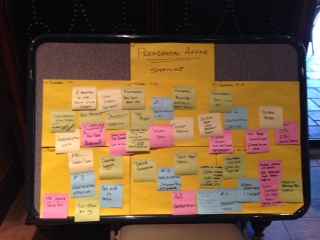 Being an author generates lots of questions from friends. Some think they might like to try their hand at publishing. For others it’s the least likely thing they’d ever do. Still, the questions come: “How do you keep track of the different characters? How do you know when they’ll react? Or, what they’re getting ready to do?”
Being an author generates lots of questions from friends. Some think they might like to try their hand at publishing. For others it’s the least likely thing they’d ever do. Still, the questions come: “How do you keep track of the different characters? How do you know when they’ll react? Or, what they’re getting ready to do?”
The questions make it sound like there’s a recipe; nothing could be further from the truth. The best I can do is explain my approach. Writing is a personal experience and each person has to find their own way to write and organize their thoughts. Of course, there are some common points—every writer has an outline—but its shape is defined differently.
Some authors write detailed outlines for each chapter. Some go to great lengths, filling up notebooks with plots and sub-plots, character descriptions and specifics about every scenario. Others paper the four walls where they write so they can jot down thoughts and see how their ideas flow.
For me it’s simple. I have a storyboard propped up in my den—a 2 x 3 foot tack board—I look at every day. It’s divided into six sections, roughly five to six chapters for each. It’s there night and day; I never know when a thought will pop into my head. There’s also a notepad on my nightstand; my brain works 24/7.
Over breakfast one morning with my brother-in-law, David Stockman, who’d served in President Reagan’s cabinet, I scribbled five pages of notes as we talked. I was researching ideas for the book I’m currently writing, Presidential Affair and could hardly wait to get home to add post-it notes to the storyboard. I quickly created several rendezvous’ between Steve Schilling (my key character) and the first female president of the United States in the secret room off the Oval Office. Before long I had written three more episodes for Steve with Hope, the president’s double.
I keep a stack of colored post-it note pads on my desk. So when I get a thought I can jot it down and slap on the board. The colored pads are nice too, because I use different colors to identify various story themes. It helps me see where the story may be slow or need a boost.
Another nice thing about the post-it’s—I can move them around; I have learned nothing is fixed in writing—episodes change, characters come and go, and chapters move around. In Costly Affair the original Chapter Eight ended up being Chapter One.
Most importantly, the storyboard is always there. It keeps me thinking about the story—what’s ahead and how to get there. Once I get close to finishing the writing about an idea on a post-it, my mind goes into high gear about the next episode. I’m busy jotting down notes, saying the dialogue in my head and listing key phrases.
And then, I let it fly. I write for an hour or two without looking up—six to eight pages of scribbles and notes. Then I start over on the same section; fine tuning, word-smithing and making it flow. While this is happening, my head is onto the next episode. Sometimes I add another post-it, and wonder “where did that thought come from?”
I stare at the storyboard, and before I know it my brain is there—in the story—telling me what to write. I lean back and look at the storyboard. Nothing has changed—the words are the same—but I’ve moved onto a place I’ve never been.
Hopefully, it is the same for you as you read my work. Are you eager to get to the next chapter? I hope so . . . I was when I was writing it.

0 Comments
Leave a reply →